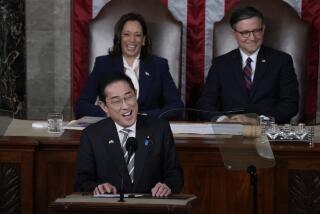Japan’s Two Economies Need to Travel One Path
- Share via
Once again, Japan is generating excitement in world markets.
International investors have poured $10 billion into Japanese stocks in the last month, and the Nikkei average of the shares of leading Japanese companies is up 16% so far this year. Exports from the country’s powerful corporations are sweeping the globe.
All that is causing some experts to ask, if tentatively, whether the world’s second largest economy finally is on its way to recovery after 12 years of recession and paralysis.
The answer, at least for now, is no. That’s because there are essentially two Japanese economies, and only one of them is showing signs of life.
Most people know the dynamic Japan of prominent companies and dominance in international trade, and that global force is doing fine. “Japan’s leading companies, Toyota, Canon, Nissan and many more, have cleaned up their balance sheets and are in the best shape in years,” says Kenneth Courtis, Tokyo-based vice chairman of Goldman Sachs Asia who has watched Japan’s economy for more than 20 years.
Indeed, Japan’s surplus on trade and investment income is running this year at $150 billion on an annual basis, thanks to exports of NEC semiconductors and Honda cars, as the Ministry of Finance noted last week in Tokyo.
But the Japanese economy that looks outward seems almost unrelated to its troubled cousin, the home-front economy of 127 million people that accounts for 85% of the nation’s gross domestic product of $4 trillion.
For this economy, the statistics are grim. Japan’s banks are burdened by more than $900 billion of bad loans. It’s an enormous total that has built up over the last decade as these institutions have rolled over debts of client companies rather than compelled the companies to repay the debts or reorganize their operations. The rollovers were done at the behest of the Japanese government in the interest of stability.
But the strategy backfired. In fact, rolling over bad loans held back new lending by the banks and led to stagnation.
Despite the Nikkei’s recent swell, stock prices in Japan today are roughly one-fourth of what they were a dozen years ago. Unemployment has been rising steadily, even though layoffs haven’t been anywhere close to the scale of those in the U.S. (In Japan, many workers are simply kept on the payrolls, at relatively low wages and often with little to do.) Personal incomes and living standards have plummeted. The homeless are dramatically evident in Tokyo’s parks.
The stalled internal economy has brought on deflation, with prices falling 1% to 3% and more a year. Deflation makes loans and mortgages harder to repay and property sales and transfers difficult, further stifling business activity.
Stalled Stimulus Plans
To spur the distressed
economy, the government has launched numerous stimulus plans, mainly pushing money into public works, which favors the construction industry -- a major backer of the Liberal Democratic Party that has ruled Japan since the end of World War II.
Government-funded initiatives have led to bizarre white elephant projects, such as little-used four-lane highways running near seasides and underused airports in isolated parts of the country.
Some funds for these endeavors have come from deposits made by Japanese citizens in Postal Savings Accounts, which the government invests. That was the great source of capital that helped rebuild Japanese industry in the decades after World War II.
But now, with capital tied up in make-work projects and in government bonds in a stalled economy, the accounts have failed to earn sufficient return to finance people’s retirements. Investment in Japanese government bonds has earned only 1.65% a year over the last decade, a rate that has left Japan’s pension system severely underfunded.
With the global side of the Japanese economy doing so well, does it matter that, back home, the economy is such a mess?
It does. Japan can’t afford a weak and isolated domestic economy -- and the United States can’t afford for Japan to have one either. Japan is a leading U.S. trading partner and lender-investor, with the Japanese government holding an estimated $500 billion in U.S. Treasury notes and bonds.
Japan literally holds a mortgage on the U.S. economy.
A Shift Toward Reform
Change is necessary, and it may well be on its way. “Japan has approached financial collapse in the last year,” says economist Adam Posen of Washington’s Institute for International Economics. “It has dodged the bullet, but the crisis may have swung the consensus toward reform.”
Reform will come in the restructuring of domestic institutions to make them behave like Japan’s successful international companies.
New ways are being tried at a couple of banks, notably Shinsei Bank (the name means “new birth”) that was created out of the failed, government-owned Long-Term Credit Bank three years ago.
Shinsei devotes half of its business to underwriting bond and stock issues for corporations, like a U.S. investment bank.
“Japanese companies are reducing their dependence on bank borrowing and raising money through public markets,” explains Shinsei’s chief executive, Masamoto Yashiro. “Japan is changing. That’s why international investment is coming in.”
But, he cautions, this is still Japan. Nothing will happen quickly. “The reform will take two to three years.”
Whether the two Japans succeed or fail, the United States and much of the rest of the world will be profoundly affected.
*
James Flanigan can be
reached at jim.flanigan@
latimes.com.
More to Read
Inside the business of entertainment
The Wide Shot brings you news, analysis and insights on everything from streaming wars to production — and what it all means for the future.
You may occasionally receive promotional content from the Los Angeles Times.










